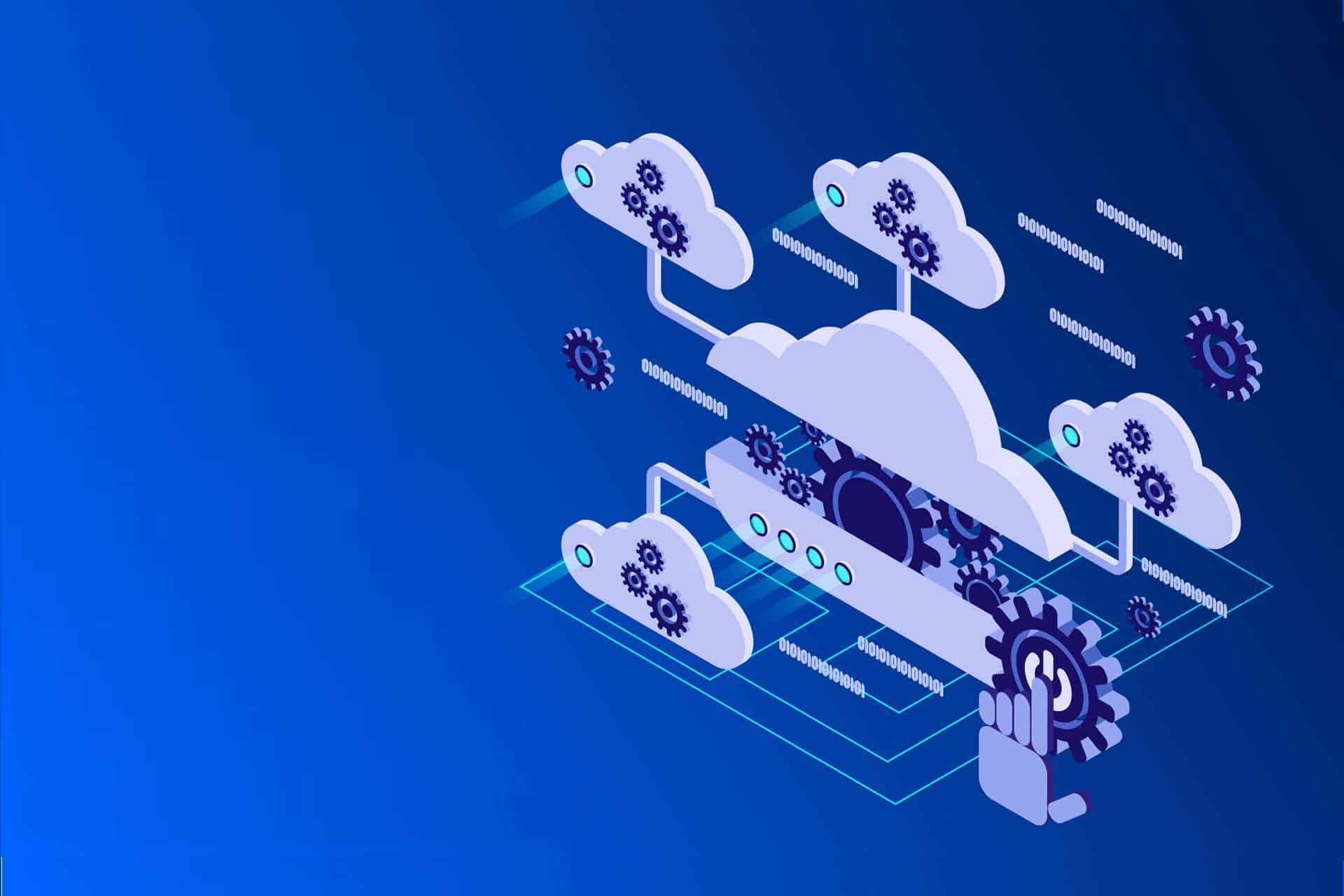Hybrid cloud architecture allows a company to combine a tightly controlled on-premise infrastructure with the power of a public cloud service. Due to their high flexibility, hybrid cloud solutions are the preferred option for modernizing both existing and legacy applications.
This article is an introduction to hybrid cloud architecture. Read on to learn how companies set up hybrid systems to achieve technical and business goals more effectively than with a public or private cloud alone.

Hybrid Cloud Architecture Explained
Hybrid cloud architecture is a mix of two or more different types of infrastructure (public, private, community clouds, bare metal, etc.) bound together into a single system with total workload and data portability. These architectures vary based on business needs, but the most common systems combine:
- An on-premises system (bare metal or private cloud) with a public cloud.
- A public cloud, private cloud, and bare metal infrastructure.
- Two or more private clouds.
- Two or more public clouds.
Regardless of the specific setup, every hybrid cloud architecture has four traits in common:
- Network connection. Different environments in a hybrid cloud share the same connections, either within a private network or via the Internet.
- Full integration. Data and workload synchronization occur across every component of a hybrid cloud.
- Quick resource provisioning. A hybrid cloud can swiftly provision new resources, typically via a third-party public cloud.
- Unified management. The team manages a hybrid setup through a single tool, with each environment running on the same operating system.
The connection between different components is the main feature of a hybrid cloud. A hybrid offers a unified cloud computing system that allows admins to move services between the environments.
If there is no integration between components, a company does not have a hybrid system. Instead, the setup runs several clouds in parallel and is likely a form of multi cloud.
Learn the difference between multi and hybrid cloud, two similar deployment models that lead to entirely different IT environments.
Three main aspects of designing a hybrid architecture are connectivity, app modernization, and cloud security.
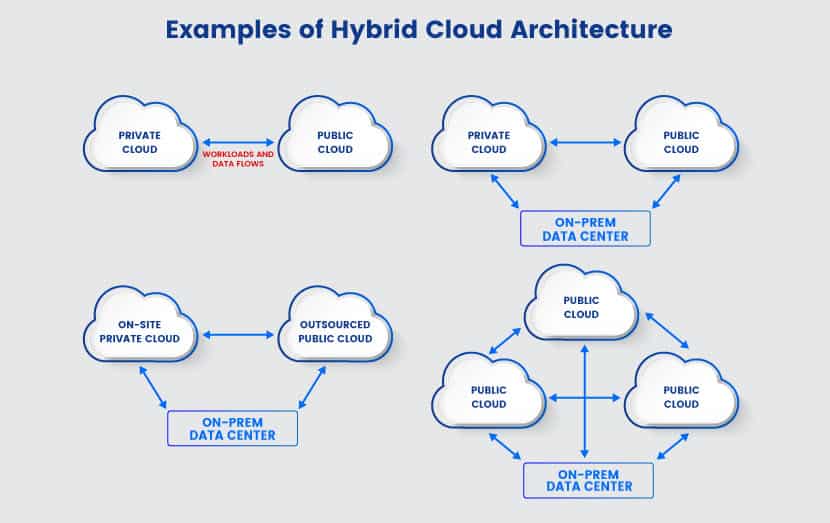
Connectivity
Connectivity and interoperability are core concepts of a hybrid cloud architecture. This feature allows:
- Free movement of workloads.
- Unification of management.
- Orchestration of processes.
The level of connectivity directly impacts how well the hybrid cloud works. To illustrate the importance of interconnectivity in a hybrid environment, we will consider an example of a stock trading and storage application. As shown in the diagram below, the app relies on both a private and a public cloud.
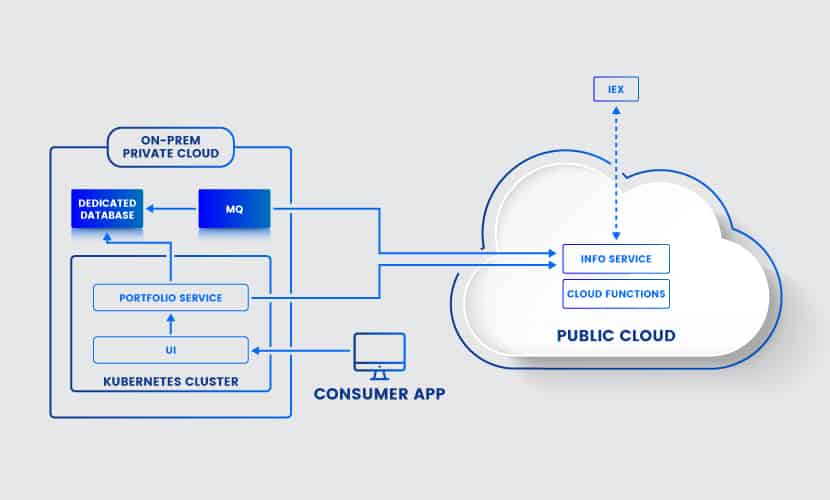
When someone accesses our example app, the user hits an endpoint on a private cloud and feeds into the on-prem Kubernetes cluster. The cluster contains numerous services:
- The front end of the app (the UI).
- The MQ service for the message queuing capability.
- The portfolio service for users to manage investments.
The portfolio runs operations in the private cloud, but the service also relies on tasks in the public cloud. The central service in the public cloud is the one that fetches stock prices from the Investors Exchange (IEX).
The MQ service keeps track of the user loyalty levels. This service also requires access to the public cloud and notifies users in real-time about changes in their loyalty status or portfolio.
Our app requires high levels of interconnectivity between the private and the public cloud to work correctly. The workloads flow between environments, and the whole system operates as a single entity. The connection between the private and public cloud is vital, and we can connect the two via VPN, WAN, or an API.
Not sure whether the cloud is the right option for your use case? Our comparison of on-premise and cloud computing will help you choose the right approach.
Application Modernization
Modernizing monolithic apps and moving them to the cloud is among the biggest challenges of hybrid cloud adoption.
Let us say that our stock trader app began as a monolithic, on-prem system. The app was Java-based and had the same services as in the public-private cloud setup above:
- The UI.
- The portfolio service.
- MQ service.
- A connection to the IEX.
- An on-premise database.
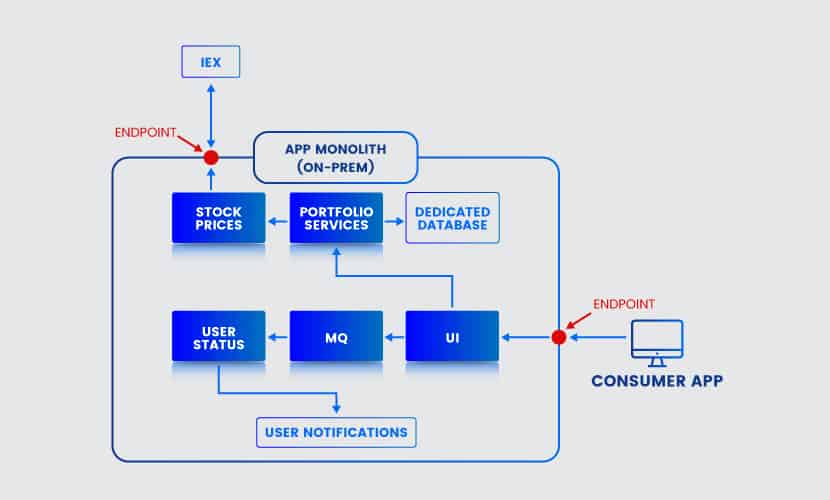
At some point, architects had to break our fictional app apart and deploy it to the cloud to prevent user latency.
App deconstruction begins with identifying the pieces to break out of the monolith and deploy to the cloud. Some components are better options than others. In our example, deploying the portfolio to the cloud would result in numerous unnecessary network hops and significantly increased latency.
Moving the UI to the cloud is a good option. As latency is the main issue, deploying the app’s front end to multiple locations can lead to a better user experience.
Once you know which piece will go to the cloud, the next step is refactoring. Architects need to create glue code that allows the app to keep the communication pathway between services. Once we refactor the UI, we can deploy the service to the public cloud. We direct only a small percentage of users to the cloud while we test the new flow.
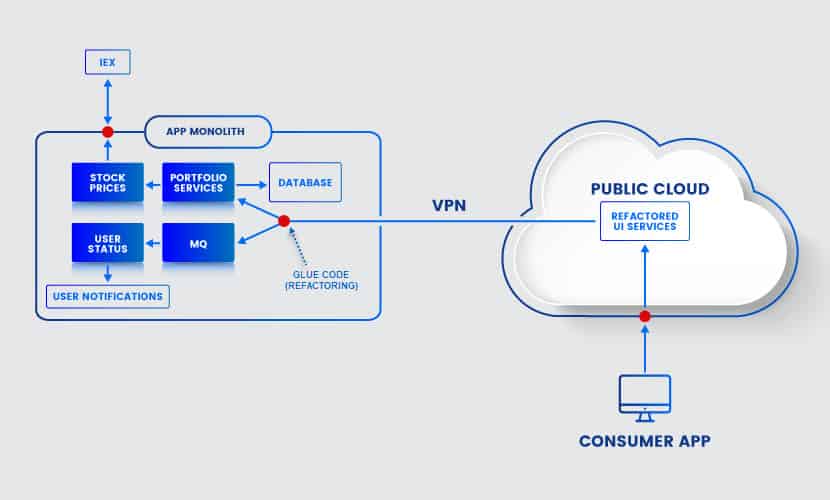
Once the public cloud setup is error-free, we can deprecate the old UI portion and start using the cloud for all traffic. Now we can begin thinking about what other services we can migrate and expand our hybrid cloud architecture.
Hybrid Cloud Security
Cloud security in a hybrid system is challenging because the team must protect multiple environments and the data exchanged between them. There are two major security concerns when designing a hybrid cloud architecture:
- Potential data breaches.
- Strict privacy laws such as GDPR, HIPAA, and PCI.
The starting point is to identify the cloud security risks that come with your north-south and east-west network traffic. North-south traffic refers to any activity that travels from end-users to data centers or cloud environments. East-west traffic is the data flowing between hybrid cloud components.
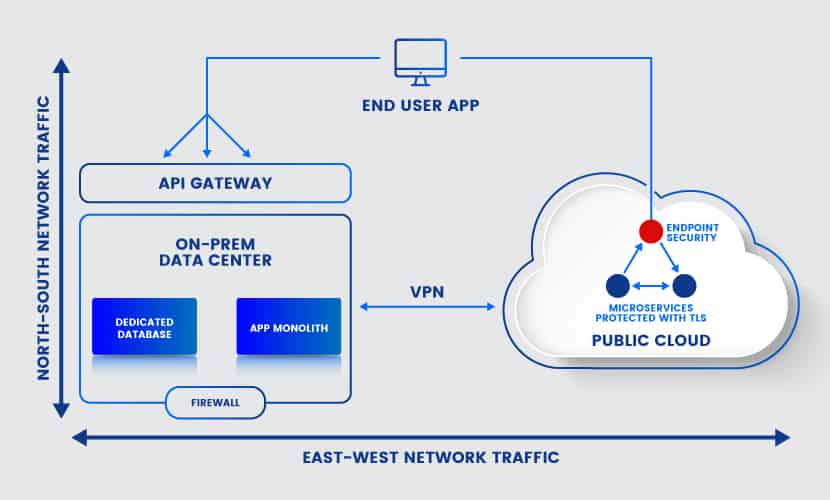
Perimeter security is crucial to any hybrid cloud architecture with on-prem components. Whether you are running a bare-metal data center or a private cloud, ensure that the perimeter has:
- A firewall.
- Endpoint security with secure API gateways.
- Zero-trust security
Public cloud security is primarily the provider’s responsibility, but the client also plays a part. For instance, when you have a Kubernetes worker with multiple cloud services, fine-tuning the component’s endpoint security and request authentication falls under the client’s responsibility.
Securing east-west traffic in a hybrid cloud architecture requires ensuring safe communication between environments. Network segmentation is a good tactic for protecting east-west traffic. Create strict policies that limit what segments users, admins, and processes can access.
In a Kubernetes environment, micro-segmentation requires you to set up TLS certificates for requests going between microservices. Encrypt requests and data (both in transit and at rest) as early in their lifecycle as possible. Another Kubernetes best practice is to set up an admission controller that adds further levels of verification after initial authentication.
Learn how to create an effective cloud security policy, a crucial aspect of protecting your cloud environments.
Types of Hybrid Cloud Architecture
Since private clouds are unique and public cloud providers offer diverse services, there are no one-size-fits-all hybrid solutions. However, every hybrid cloud corresponds to one of two primary types: traditional and modern hybrid cloud architecture.

Traditional Hybrid Cloud Architecture
Traditional hybrid cloud architecture focuses on transforming data centers into private clouds. Once the on-prem setup is ready, the team designs a connection with a public cloud to create a seamless workload and data flow. This unified IT infrastructure is ideal if:
- The organization needs to keep sensitive data in a private cloud due to regulatory concerns.
- The team aims to migrate existing on-prem workloads to a public cloud, reducing the data center footprint.
- The company wishes to migrate to the cloud to enhance legacy apps and improve performance.
- The team wants to use the public cloud to quickly spin up development and testing resources (an ability vital to efficient DevOps teams).
- The business wishes to migrate inconstant workloads to the public cloud.
Typically, traditional hybrid cloud architecture relies on a prepackaged solution or enterprise-grade middleware that integrates cloud resources across environments. A central console and unified cloud monitoring tools keep the setup in good health.
Modern Hybrid Cloud Architecture
Modern hybrid cloud architecture focuses less on connectivity between components and more on the portability of workloads. That way, the system can seamlessly use the best environment for any task.
This type of hybrid cloud architecture enables organizations to leverage cloud-native technologies and utilize microservices to divide applications into smaller, reusable components. Microservices ensure consistent and reliable deployment, management, and performance across different clouds and vendors.
In modern hybrid cloud architecture, the lines between public and private clouds are less distinct. Many providers now offer public cloud services that run in the client’s on-premise data center. Private clouds, which traditionally run on-premises, can now operate:
- In an off-premises data center.
- On virtual private networks (VPNs).
- As a virtual private cloud (VPC).
Infrastructure-as-code (IaC) is a significant aspect of modern hybrid cloud architecture. IaC allows developers to spin up new environments quickly and on demand.
Designing and Building a Hybrid Cloud Architecture
Before designing a hybrid cloud architecture, consider the checklist below to ensure your plan does not run into any pitfalls.
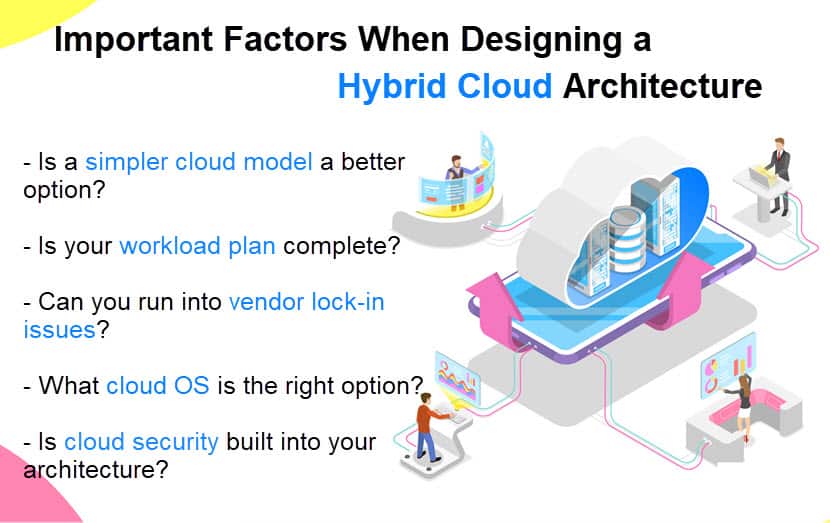
Consider Simpler, Less Expensive Deployment Models
A hybrid cloud relies on complex integration between different environments, making the setup an ideal fit for high-volume workloads and distributed systems. If your app has intense workloads and doesn't require flow overlap, a simpler cloud model might be a better option.
As the app and its user base grow, consider expanding to a hybrid cloud to maintain performance levels.
Our article about the different cloud deployment models helps identify the right option for your use case.
Make an In-Depth Plan for Your Workloads
Begin by designing the architecture, determining how and where each workload will run. This plan requires a delicate balance between:
- In-house accessibility needs.
- Compliance requirements.
- Application needs.
Consider the following factors when planning which environment to use for each workload:
- Security levels.
- Service price.
- App requirements.
- Accessibility.
- Legal obligations.
- User locations.
If your company processes sensitive data, plan where you will store that info and what systems will have access to valuable data. Also, consider if some legacy systems will be unable to operate correctly in a cloud environment.
Be Wary of Vendor Lock-In
Building a hybrid cloud on a platform that cannot handle your workloads can lead to costly issues in the future.
Teams looking for a SaaS partner have a bigger margin for error, but companies that want to build an app through a PaaS or IaaS provider must make the right choice from the start to avoid serious vendor lock-in issues. When choosing your cloud service provider, consider the following:
- Service cost.
- Used technologies.
- Management tools.
- Physical locations of data centers.
- Service-level agreements (SLAs).
- Support for bare-metal and private cloud environments.
- Security, governance, and business policies.
- Service dependencies.
Understand the difference between IaaS, PaaS, and SaaS, three of the most common types of cloud services.
Pick the Right Cloud OS
A cloud operating system enables a team to monitor and manage a hybrid environment through a single set of tools. Cloud OS should simplify management and grant agility, so choose the software that fits your developers’ needs. Some of the most popular options are:
- Kubernetes.
- VMware Cloud.
- OpenStack.
- Nutanix.
Choose the cloud OS based on which tool offers the right data management approach. Ideally, the OS should not require you to retrain the entire IT staff.
Build Security into Your Hybrid Cloud Architecture
Treat security policies and controls as a fundamental piece of your hybrid cloud architecture. Security should not be an afterthought, so ensure proper protection levels are a building block for every environment.
Start thinking about cybersecurity risks as early in the design process as possible. DevSecOps is a good approach when building cloud systems if you wish to think about security from the ground up.
An Ideal Cloud Option for Application Modernization
Hybrid cloud architecture enables companies to modernize their applications by integrating cloud services with their existing IT infrastructure. This approach makes hybrid clouds an ideal option for any company that wishes to use cloud computing while keeping tight control over its IT setup.



